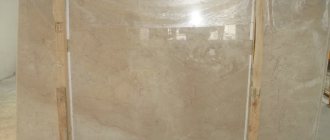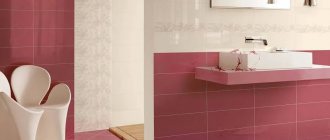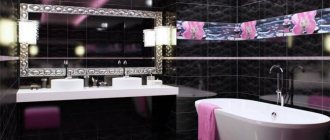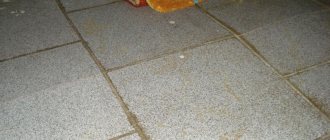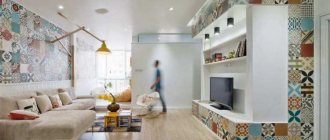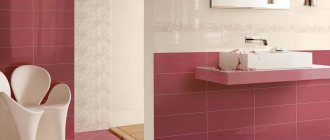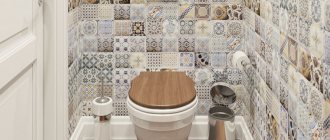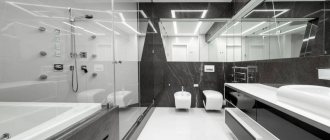Choosing tiles for the bathroom and toilet will not be difficult if you understand the features of the products and know what aspects you should pay attention to. In this case, not only the aesthetic component is important, but also the quality of the ceramics, since the finish is usually designed to last for many years. And to choose the best option for a specific room, the easiest way is to use the advice of designers. This will help hide the shortcomings of the bathroom or bathroom and create an attractive environment.
Types of tiles suitable for bathrooms and toilets
Typically, when covering walls and floors in rooms with high humidity, several types of products are used:
- Ceramics. It is used most often and is made of clay, and the surface can be either perfectly smooth or textured. The material is not afraid of moisture and lasts for decades. The only negative is that if there is a strong pointed impact or a heavy object falling on the floor, the tiles may crack. It is worth noting that there is a huge selection, so it is easy to choose the ideal color for any interior.
- Glass elements do not differ from standard ones, but have an original appearance and can be either transparent or colored, and the surface can be made smooth or textured. You can place decor in the form of sparkles or other elements under the tiles, which will add originality to the decor. Glass is scratch-resistant and does not absorb water, but is expensive.
- Porcelain tiles are highly durable and have a service life of 50 years or more. It is made from clay with composite additives, which gives the products high performance characteristics. Ideal for floor coverings as it has the highest abrasion resistance. The surface also withstands the effects of acids and other aggressive substances. The only disadvantage is the fairly large thickness and significant weight due to the high density.
- Rectified tiles can be either ceramic or composite. Its main feature is the processing of the ends, which allows you to get perfectly smooth edges. Due to this, it is possible to cover the surface with minimal joints, and no adjustment of elements is required. This processing method is being introduced by more and more manufacturers. It is predicted that this particular option will be the most popular on the market.
You should also look at the main types of ceramics. For the bathroom and toilet, one of three options is almost always used:
- Earthenware products are made from white clay, which ensures high reliability even with small thickness. This raw material is considered the best. The technology involves pressing blanks and subsequent double firing, and to increase reliability, fire-resistant components are added to the composition. The price of such ceramics is very high. It is usually used for wall decoration.
- Majolica is made from red clay. Often hand painting is applied on top of the glaze layer. Such solutions are expensive and are not suitable for use directly near a bathtub or sink, as the pattern may wash off over time.
- Gres. The raw material can be either white or red clay. The main feature is pressing at high pressure and further firing, which ensures high density and strength of the surface even without applying glaze. But at the same time, the weight of the cladding is an order of magnitude greater than that of its analogues.
By the way!
When choosing, give preference to well-known manufacturers.
Which tile to choose for the bathroom
It is important to know the following:
- Purpose. If there is a foot symbol, then the tile is suitable for the floor. When a hand is depicted, it can only be used for wall cladding. Usually the collection includes options for different surfaces.
- Tile thickness. It may be different, but the larger it is, the stronger the product.
- The coefficient of friction (symbol of a foot at an angle to the surface) shows how safe it is to walk on wet tiles. This factor is important for floor coverings.
- Abrasion resistance is indicated by the letters PEI and numbers from 1 to 5. Options with values 1, 2 and 3 are suitable for walls. 4 and 5 are intended for industrial use. They are not used for home use due to their high price.
- The packaging is also marked with resistance to aggressive chemical influences. For marking, Latin letters are used from A (minimum durability) to D (maximum performance).
Advice!
For plasterboard walls, it is better to select tiles that are not very heavy, so as not to create too much load on the surface.
Wallpaper
Even high-quality paper, especially vinyl or non-woven wallpapers are suitable for decorating walls in the dining room, kitchen or bathroom, if combined with tiles, covering the most “problem” places: above the stove, sink, toilet, bathtub. This is not to mention washable wallpaper, glass wallpaper and special canvases for painting. With their help, you can create a unique interior design and save a lot on repairs.
It is permissible to combine different materials in one room: tiles, mosaics, wallpaper, laminate.
By color
The main factors you need to consider will be the size of the bathroom and its shape, the height of the ceilings and the availability of natural light. Remember the following:
- For a small bath or toilet, do not use dark colored ceramics, as this will further reduce the space. Light colors are best.
- You should be careful with matte products - they are not very suitable for walls in small rooms. But at the same time, textured tiles on the floor are most preferable.
- White color should also not be used, since dirt and plaque are best visible on it, and the room looks like a hospital. But if you liven up the decor with contrasting inserts or use elements with patterns, the appearance of the bathroom will be transformed.
- To visually enlarge the space, you can lay elements of contrasting tones diagonally. For visual expansion, use horizontal stripes, and for rooms with low ceilings, vertical layout options are more suitable.
- If you cover one of the walls with decorative tiles with patterns or ornaments, and finish the rest with plain ceramics, the bathroom will become more comfortable and visually larger. The main thing is to choose the optimal combination of shades.
- Try to purchase tiles from the same collection. Then you won't have to worry about whether different solutions will fit together.
- If you use a large number of dark tiles with a glossy surface, the interior will turn out stylish and sophisticated. Bright elements will make the bathroom modern and original. Neutral and pastel colors are universal, allowing you to visually expand the space and make it cozy.
By the way!
When purchasing tiles, be sure to check that all boxes are from the same batch. The fact is that products produced on different days or shifts may have slight differences in shade.
How to determine quality
Deciding on technical parameters and color is not everything. We still need to check the quality. To avoid problems during installation and operation, the tiles in the bathroom must be of high quality, and the quality can be determined even visually:
- There should be no glaze defects on the front surface. In fact, our GOST allows no more than two glaze detachments on one fragment. In this case, the batch is considered to be of high quality. But who needs tiles in the bathroom with defects that will lead to an increase in the absorbency of the finish? Therefore, if they have the means, even despite significantly higher prices, they buy imported tiles. In it, such a defect is very, very rare, while domestic ones can be - every fourth one has a defect.
If there is a difference in size, you might end up with something like this - It is necessary to examine and compare several tiles from one pack to ensure that the sizes match. Ideally, they should not differ (imported), but in reality a difference of plus or minus a millimeter is considered normal. Then when laying you will have to use crosses of two sizes - say 2.5 mm and 3 mm. In finished form, the difference is almost invisible.
- You also need to check the flatness of the tiles. It should be smooth, without bends. In this case, it is easy to put it down. But there are batches with a concave or convex middle, with protruding edges, etc. All these are signs of low quality tiles.
- You need to look at the back side too. It should be smooth, dense, uniform, without large pores. The loose back side absorbs a lot of moisture. These tiles are not suitable for the bathroom. We'll have to look for another option.
All these operations must be carried out not with one tile, but with several, preferably from several boxes. If after inspection you are satisfied with everything, you can move to the checkout.
By shape and size
Ceramics are divided into 4 groups:
- Mosaic. It usually has a square shape, the side size varies from 1 to 5 cm. An original solution that will not be cheap.
- A small square tile has a side of up to 10 cm. A rectangular tile can have a long side of up to 15 cm.
- Medium options are usually no more than 30 cm for a square shape and 40 cm for a rectangular shape.
- Large tiles include all tiles that are larger than the above parameters. Usually these are options from 40x40 cm and more.
As for the shape, the most common are square and rectangle. Rectangular tiles can have different aspect ratios: from 1:1.5 or more.
You can also find other options - hexagon, polygon, irregularly shaped elements that are combined in a strictly defined way and create a pattern on the surface. They usually cost more and are more difficult to install.
By the way!
If you decide to use mosaics in the bathroom, the easiest way is not to purchase the classic version, but modern products, which are segments that are attached to a flexible fiberglass base. Then installation will take much less time.
By bathroom area
To achieve the best effect and smooth out the imperfections of the bathroom, use several recommendations:
- Select the size so that there are at least 3 whole elements on the short side. It’s better if several rows fit on the surface.
- If the space is narrow, use wide elements placed horizontally. If the ceilings are low, rectangular ceramics should be placed vertically to visually increase the height.
- Almost any option is suitable for spacious rooms. There are no restrictions on size and shape. Color may also vary. The main thing is to decide on the design concept in advance.
- In small bathrooms, it is better to use light colors, and the surfaces should reflect light well. It is important to position the plumbing fixtures correctly so that they do not clutter up the space.
You should not choose exotic colors and shapes for a small room. It is better not to experiment in a limited area.
By design
There are a few simple rules that will allow you to choose the right color and design of tiles:
- Choose similar tile textures for walls and floors. For example, if you like some natural materials (imitation wood, stone, etc.), they should be present to one degree or another on all surfaces.
- Remember the universal rule for choosing tiles: dark or medium tone for the floor, light walls and white ceiling. This formula is suitable for all spaces. The main thing is that the tones of the materials on the floor and walls are combined with each other.
- When choosing decorative inserts, it is best to use products from the same collection. Choose options that have what you need. At the same time, it is very important to correctly arrange different types so that their combination looks harmonious.
- If a certain direction is chosen, then the tile design is selected to match it. Ultra-modern solutions will not look good with classic plumbing fixtures. Therefore, you should think through the concept in advance so that you don’t have to change the design.
By the way!
Manufacturers often offer ready-made layouts that can be displayed on stands or presented in catalogs. This is a great solution because you can evaluate the appearance and see if it suits you.
Stone
By successfully combining ceramic tiles with artificial stone or natural rock, you will get a respectable interior with a strong personality, because the design will always be unique. This solution is definitely suitable for those who need to beautifully decorate a small studio apartment and softly play up the transition from the kitchen to the dining room or living room.
It’s easy to emphasize the richness and naturalness of the matte, rough structure of the stone using glossy tiles - add them to adjacent walls or lay them on the floor.
Which bathroom tiles are better – matte or glossy?
To determine which option is better, it is worth analyzing the advantages and disadvantages of each of them:
- Due to the excellent reflection, you can fill the bathroom with light. This variety visually expands the space, which is very important.
- Reflective surfaces look great in luxurious settings and add sophistication to the room. Moreover, you can select varieties with different degrees of reflection to ensure the desired effect.
- On glossy tiles dirt is very visible, so you will have to constantly wipe the surface. Over time, limescale becomes harder and harder. Even simple touches leave stains. Gloss is not used on the floor.
Matte ceramics are more practical from the point of view that there are no marks left on the surface, and dirt is much less visible. These are the solutions most often used in bathrooms; the main features are:
- These tiles fit perfectly into modern interiors.
- The water-repellent characteristics of the surface are very high, which is important in wet rooms.
- Caring for the surface is much easier - just wipe it with a damp sponge from time to time.
- By combining with patterned tiles you can achieve originality in the interior.
By the way!
In some cases, you can combine glossy and matte elements to highlight the features of the interior.
Types of tiles
There are three types of tiles, based on their surface:
- Matte: design-savvy people advise choosing this type of tile, because it fits into the interior of the room much better than glossy;
- Glossy: unlike matte, it copes well with stains and reflects soft highlights;
- Mirrored: this tile helps to visually enlarge the room and is much more expensive than the previous two. As a rule, it is not used to cover the entire wall, but only a small part of it; it can also be used as a mirror.
Fourthly, when choosing a color scheme, you need to rely on the size of the room. For example, large bathrooms can allow for a greater variety of shades, while small rooms will have to take longer to decide on the choice.
Designer tips for choosing bathroom tiles
Nowadays you can easily find a photo of a bathtub design. This is an excellent solution, as you will see what this or that combination looks like and will be able to choose the appropriate design. Please note the following:
- Light ceramics are much more practical than dark ones.
- Large elements look more attractive, but you should remember the proportions - at least 3 tiles per wall. If you can't fit that much, choose a smaller option.
- Various borders and decorative elements are a sign of bad taste.
- Imitation of marble or other stone is very popular. But it is very important that the structure is as natural as possible - you should not purchase obvious fakes.
- Square or rectangular wood-look tiles are perfect for the floor. You can also choose a similar solution for the wall, but with a less distinct texture.
- Patchwork style tile inserts are well suited for decorating a bathroom. Bright patterns attract attention and make the interior much more dynamic and attractive.
- Use no more than three primary colors in the bathroom. Most often, the bottom is dark, the middle is light, and the top is white.
- Of the glossy options, only the “hog” tile, which imitates brickwork, is relevant.
By the way!
Pay attention to the choice of grout. If you need to highlight the seams, purchase a contrasting option; if you want to hide them, try to find a tone that is as close as possible to the color of the ceramic.
Bathroom tiles should not only be beautiful, but also practical. Consider the area of the room, its features and be sure to look at examples of finished interiors to find a suitable idea and implement it.
Color combinations
This is a matter of taste, but many owners want to keep up with fashion when undertaking renovations. Natural natural tones are still in trend, but daring “artificial” shades also find their place within popular styles: hi-tech, eclecticism, pop art.
Let us outline the universal rules for combining tile colors in the interior:
- 1 beautiful tone all alone or against a neutral background (from white through gray to black);
- 2 rich contrasting shades (purple/yellow, wine/ochre);
- 3 colors, one of which is neutral, the remaining two are close in the palette (graphite/electric/turquoise, concrete/pistachio/lemon);
- 4 tones, three of which are neutral, and one is a bright accent, or three shades of the same color of different saturation on a neutral background (black/gray/white/red, white/gradient from cornflower blue to pale blue).
Based on these simple principles, it is difficult to make a mistake, but deviating from them, you can get a harmonious result, this is obvious in the example below.
There is only one unshakable rule - a tiny kitchen or bathroom should not be decorated with too dark tiles, because this will visually reduce the already modest area.

